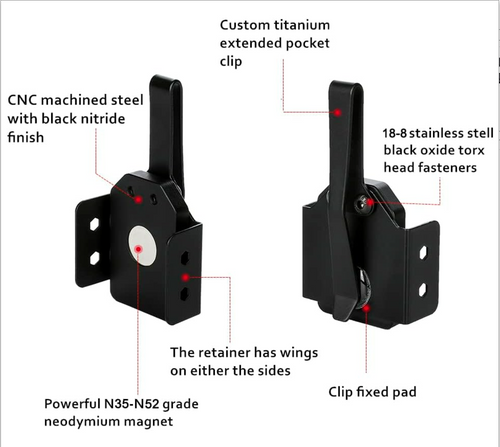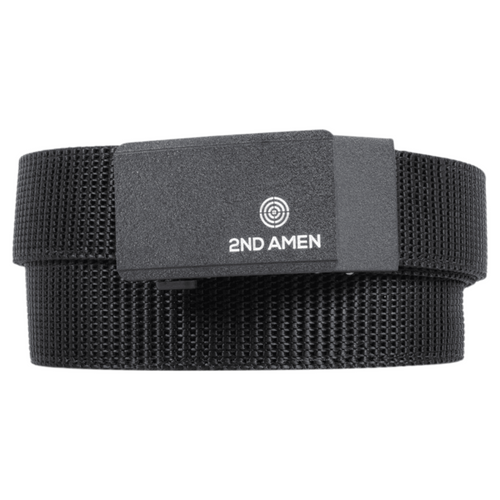Holster testing ensures your firearm is safe, comfortable, secure, and accessible during daily use. Here's what you need to know:
-
Key Factors to Test:
- Safety: Trigger guard coverage, secure mounting, and retention strength.
- Comfort: Fit, weight distribution, and material flexibility for long-term wear.
- Retention: Stability during movement, resistance to shifting, and draw reliability.
- Accessibility: Smooth, quick draws from various positions and concealment depth.
-
Testing Methods:
- Physical Tests: Perform activities like jumping, sprinting, and bending to check firearm security.
- Draw Speed: Time your draw from standing, seated, and crouched positions.
- Concealment: Test with different clothing to ensure the firearm stays hidden.
- Durability: Expose the holster to sweat, rain, and temperature changes to assess wear.
- Safety First: Always use inert training firearms, follow safety protocols, and document results for improvement.
The Houdini Holsters Breakout 2.0 combines secure retention, fast access, and discreet concealment, making it a dependable choice for everyday carry. Testing your holster regularly ensures reliability and sharpens your skills.
19 Point Torture Test - How Alien Gear Holsters Tests Products

Testing Goals and Standards
Start holster testing with clear, measurable goals to evaluate how it performs under real-world conditions. These goals will guide the testing process and ensure a thorough assessment.
Secure Hold and Quick Access
Finding the right balance between keeping the firearm secure and allowing fast access is key. A reliable holster should hold the firearm securely during everyday movements while still enabling a smooth, quick draw. Test this by running simulated draw drills and handling exercises to confirm the holster stays in place and operates consistently.
Long-Term Performance
Check durability by assessing how the materials hold up over time, especially at stress points. Also, test the hardware to ensure it performs well with repeated use. Houdini Holsters backs its commitment to quality with a lifetime guarantee, reflecting confidence in the long-term reliability of its products.
Daily Wear Comfort
Comfort is critical for consistent use, which directly impacts readiness. Test for comfort by examining fit, pressure points, and overall ergonomics during extended wear. Be sure to consider a variety of body types and clothing styles to ensure the holster works well for different users.
Test Setup Guidelines
To achieve accurate performance measurements and maintain safety, a well-organized and controlled setup is essential.
Tools and Equipment You’ll Need
Make sure you have the following: inert training firearms, safety gear (like eye protection and appropriate clothing), timers or recording devices, and markers for defining test zones.
Once you’ve gathered these items, set up your environment to replicate a range of everyday conditions.
Setting Up the Test Area
Choose a spacious location that can simulate real-life scenarios. Create specific zones for static draws, movement drills, and concealment tests. Adjust elements like lighting and surroundings to mimic different visibility levels and ambient environments.
Before starting, revisit key safety protocols to ensure everything runs smoothly.
Prioritizing Safety
Follow standard firearm safety procedures throughout the testing process. Double-check that all equipment is functioning properly and confirm the area is secure. Clear communication and designated safe zones are crucial, especially when evaluating features like the retention system and quick-draw performance of the Houdini Holsters' Breakout 2.0 IWB holster.
sbb-itb-7fb5bb8
Test Scenarios
With your testing area ready, it's time to evaluate holster performance through specific, practical scenarios.
Firearm Security Tests
Try activities like jumping jacks, sprints, and knee bends while wearing the holster. The Breakout 2.0 IWB holster is designed to keep the firearm secure during these movements.
For more intense testing, add short sprints, repeated calisthenics, padded tactical rolls, and quick directional changes. Keep an eye on the holster for any shifting or loosening. Once retention is confirmed, move on to testing draw speed and handling.
Draw Speed and Handling
Use a shot timer to measure draw speed and handling from various positions, such as standing, seated, or crouched. For instance, practice drawing from a standing position at different angles, from a seated position (like in a car or office chair), and from a crouched defensive stance. The Breakout 2.0's quick-release mechanism is designed to enable fast and smooth draws with regular practice.
Concealment and Fit Tests
After testing draw performance, check how well the holster conceals the firearm during everyday movements. Test concealment with different clothing options, such as untucked t-shirts, button-down shirts, light jackets, and athletic wear. Look for any signs of printing or exposure during activities like reaching, bending, getting into a car, or brisk walking.
Stress and Weather Tests
Wrap up your evaluation by exposing the holster to challenging conditions, including high humidity, extreme temperatures, light rain, and heavy sweating. Note any changes in material, retention, or draw consistency to assess its durability.
Safety Guidelines
When testing holsters, safety should always come first. Following strict procedures and keeping detailed records can help avoid accidents while collecting useful performance data.
Training Firearm Rules
Only use inert training firearms or unloaded firearms that have been thoroughly cleared. To clear a firearm:
- Remove the magazine.
- Check the chamber visually and physically to ensure it's empty.
- Use a visible chamber flag.
- Have a qualified partner double-check the firearm's status.
Test Records and Tracking
Keep detailed logs for each test session. Your log should include:
- Date & Time: Record the full timestamp.
- Environment: Note factors like temperature, weather, and lighting.
- Scenarios: Describe the movements or actions tested.
- Equipment: List the firearm model, holster setup, and clothing used.
- Results: Document retention performance, draw times, and comfort ratings.
- Issues: Record any problems or malfunctions encountered.
Capture photos or videos of the tests and document any needed adjustments. This level of detail not only reinforces safety but also helps improve future testing.
Practice Drills
Once safety measures are in place and documented, structured practice drills can help improve skills.
- Basic Draw Series: Perform 15–20 slow, controlled draws to focus on grip and retention pressure.
- Movement Integration: Add simple sidesteps or pivots for about 10–15 minutes to build muscle memory.
- Position Transitions: Practice drawing from standing, seated, and kneeling positions in 5-minute increments. Track which positions need more practice.
Houdini Holsters Performance Features

Building on our testing results, the Houdini Holsters Breakout 2.0 is crafted to perform reliably in everyday situations. This handcrafted, patent-pending holster is designed with comfort, concealment, and quick access in mind. Made in the USA and tailored for popular handgun models, it also comes with a lifetime guarantee, reflecting its dependable build.
Secure Retention and Fast Access
The Breakout 2.0 is designed to keep your firearm firmly in place while allowing for a smooth, quick draw when needed - perfect for practical carry scenarios.
Discreet Concealment
Its slim design and ergonomic shape ensure your firearm stays hidden without compromising ease of use.
Built to Last
Made for daily use, the Breakout 2.0 is rigorously tested for quality at the U.S. manufacturing facility to ensure it stands up to wear and tear.
All-Day Comfort
Whether you're on the move or stationary, the Breakout 2.0 is built for comfort and a secure fit, making it suitable for a variety of situations.
Conclusion
Thorough testing of holsters is crucial to ensure they perform reliably in everyday and high-pressure situations. Evaluating factors like security, draw speed, concealment, and durability helps users choose the right equipment for their needs.
Testing confirms a holster's ability to provide secure retention, smooth drawing, all-day comfort, discreet concealment, and long-lasting durability.
These insights shape the design and quality of holsters like the Houdini Holsters Breakout 2.0. With its patent-pending design, U.S. craftsmanship, and solid guarantees, it stands out as a dependable option.
Holster testing combines performance metrics to ensure functionality in both routine and high-stress scenarios. Following strict testing protocols not only confirms reliability but also sharpens the handling skills needed for effective use. Regular testing, tracking retention changes, and consistent training are key to maintaining your holster's reliability for everyday carry.




